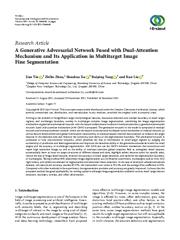A Generative Adversarial Network Fused with Dual-Attention Mechanism and Its Application in Multitarget Image Fine Segmentation
Jian Yin, Zhibo Zhou, Shaohua Xu, Ruiping Yang, Kun Liu, Yugen Yi
2021
Computational Intelligence and Neuroscience
Aiming at the problem of insignificant target morphological features, inaccurate detection and unclear boundary of small-target regions, and multitarget boundary overlap in multitarget complex image segmentation, combining the image segmentation mechanism of generative adversarial network with the feature enhancement method of nonlocal attention, a generative adversarial network fused with attention mechanism (AM-GAN) is proposed. The generative network in the model is composed of residual
more »
... rk and nonlocal attention module, which use the feature extraction and multiscale fusion mechanism of residual network, as well as feature enhancement and global information fusion ability of nonlocal spatial-channel dual attention to enhance the target features in the detection area and improve the continuity and clarity of the segmentation boundary. The adversarial network is composed of fully convolutional networks, which penalizes the loss of information in small-target regions by judging the authenticity of prediction and label segmentation and improves the detection ability of the generative adversarial model for small targets and the accuracy of multitarget segmentation. AM-GAN can use the GAN's inherent mechanism that reconstruct and repair high-resolution image, as well as the ability of nonlocal attention global receptive field to strengthen detail features, automatically learn to focus on target structures of different shapes and sizes, highlight salient features useful for specific tasks, reduce the loss of image detail features, improve the accuracy of small-target detection, and optimize the segmentation boundary of multitargets. Taking medical MRI abdominal image segmentation as a verification experiment, multitargets such as liver, left/right kidney, and spleen are selected for segmentation and abnormal tissue detection. In the case of small and unbalanced sample datasets, the class pixels' accuracy reaches 87.37%, the intersection over union is 92.42%, and the average Dice coefficient is 93%. Compared with other methods in the experiment, the segmentation precision and accuracy are greatly improved. It shows that the proposed method has good applicability for solving typical multitarget image segmentation problems such as small-target feature detection, boundary overlap, and offset deformation.
doi:10.1155/2021/2464648
pmid:34961814
pmcid:PMC8710171
fatcat:bbltst6hr5asdlrx4ztmlujx7a

